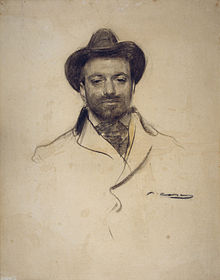Josep Maria Sert
Josep Maria Sert | |
|---|---|
 Sert seen by Ramon Casas (MNAC) | |
| Born | Josep Maria Sert i Badia 21 December 1874 Barcelona, Spain |
| Died | 27 November 1945 (aged 70) Barcelona, Spain |
| Resting place | Vic Cathedral |
| Nationality | Spanish |
| Known for | Murals |
| Style | Grisaille |
| Movement | Baroque |
| Spouse(s) | |
Josep Maria Sert i Badia (Catalan pronunciation: [ʒuˈzɛb məˈɾi.ə ˈsɛɾt]; Barcelona, 21 December 1874 – 27 November 1945, buried in the Vic Cathedral) was a Spanish muralist, the son of an affluent textile industry family, and friend of Salvador Dalí.[1] He was particularly known for his grisaille style, often in gold and black.
Career[]
Sert initially studied art in Rome before moving to Paris in 1899.[1] There, he became involved with a group of decorative artists known as Les Nabis,[1] gravitating around Paul Ranson, who had studied at the private Académie Julian, founded in 1868 by painter Rodolphe Julian.
Sert was commissioned in 1900 to paint the interior of the Vic Cathedral in the Province of Barcelona, Catalonia in murals, which took him more than 30 years to complete.[2][3]
By 1910, Sert had begun fully focusing on murals and other large-scale work. He collaborated with Russian Sergei Diaghilev to create sets for his Ballets Russes.[1] In 1929 he was commissioned with the elaboration of a series of large forma canvases painted in his signature grisaille style intending to cover the walls of the reconverted San Telmo church in Donostia-San Sebastián; they portray different historic chapters of the Basques in an epic manner.[4]
In the United States, Sert painted a mural at the Waldorf-Astoria in New York City, as well as a 1937 mural entitled American Progress at 30 Rockefeller Center.[1][5] American Progress was commissioned by the Rockefellers to replace Diego Rivera’s mural Man at the Crossroads, which Nelson Rockefeller destroyed because it included an image of Lenin.[1] He later painted the walls and ceilings of the Council Chambers at the League of Nations in Geneva.[1]
Personal life[]
Sert began an affair with the well-known pianist and patron of the arts Misia Godebska in 1908.[6] They married on 2 September 1920.[7] In 1925, Sert met Georgian-Russian sculptress Isabelle Roussadana Mdivani, known as Roussy, who subsequently moved in with him and Misia.[6] Sert began an affair with Roussy and later divorced Misia on 28 December 1927 to marry Mdivani.[7][6][8][9]
Roussy and Sert were married in 1928 in a civil ceremony at the consulate in The Hague.[6] In 1930, they were married in a religious ceremony at the Spanish church in Paris.[6]
After Roussy died in 1938, Sert reconciled with Misia and returned to life with her, though they kept separate apartments[7][6]
Sert died on 27 November 1945 in Barcelona, and left his apartment and furnishings to Misia.[7][6]
Gallery[]

Apollo flying through the Clouds (1913)

Satyr watching some Nymphs dancing (1913)

The Elephant Fountain (1913)

The Fountains Bridge (1913)

The Triumph of Apollo (1913)
See also[]
References[]
- ^ Jump up to: a b c d e f g "Who is Jose Maria Sert?". At Rockefeller Center. 12 May 2015. Retrieved 8 June 2017.
- ^ "José María Sert (1874-1945)". Museo Nacional Centro de Arte Reina Sofía. Retrieved 8 June 2017.
- ^ "Josep Maria Sert". Encyclopædia Britannica. 2016. Retrieved 8 June 2017.
- ^ Museo Municipal de San Telmo (2013). STM San Telmo Museoa : gida : euskal gizarteari buruzko museoa. Donostia-San Sebastián: San Telmo Museoa. pp. 22–23. ISBN 9788461678433. OCLC 1010512377.
- ^ "American Progress". Rockefeller Center. Tishman Speyer. Retrieved 8 June 2017.
- ^ Jump up to: a b c d e f g "Misia, Queen of Paris". Musée d'Orsay. 2006. Retrieved 7 June 2017.
- ^ Jump up to: a b c d "Sert, Misia (1872–1950)". Women in World History: A Biographical Encyclopedia. Encyclopedia.com. 7 June 2017. Retrieved 7 June 2017.
- ^ Vaughan, Hal (2011). Sleeping with the enemy: Coco Chanel's secret war. New York: Alfred A. Knopf. p. 63. ISBN 978-0-307-59263-7.
- ^ McAuliffe, Mary (2016). When Paris Sizzled: The 1920s Paris of Hemingway, Chanel, Cocteau, Cole Porter, Josephine Baker, and Their Friends. New York: Rowman & Littlefield. pp. 243–244. ISBN 9781442253339.
External links[]
- See the murals at the Rockefeller Center in New York City.
- 1874 births
- 1945 deaths
- 20th-century Spanish painters
- Spanish male painters
- Alumni of the Académie Julian
- Muralists
- Orientalist painters
- People from Barcelona
- Spanish artists
